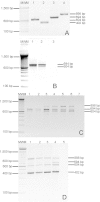Highly specific and efficient primers for in-house multiplex PCR detection of Chlamydia trachomatis, Neisseria gonorrhoeae, Mycoplasma hominis and Ureaplasma urealyticum
- PMID: 24997675
- PMCID: PMC4099392
- DOI: 10.1186/1756-0500-7-433
Highly specific and efficient primers for in-house multiplex PCR detection of Chlamydia trachomatis, Neisseria gonorrhoeae, Mycoplasma hominis and Ureaplasma urealyticum
Abstract
Background: Although sophisticated methodologies are available, the use of endpoint polymerase chain reaction (PCR) to detect 16S rDNA genes remains a good approach for estimating the incidence and prevalence of specific infections and for monitoring infections. Considering the importance of the early diagnosis of sexually transmitted infections (STIs), the development of a sensitive and affordable method for identifying pathogens in clinical samples is needed. Highly specific and efficient primers for a multiplex polymerase chain reaction (m-PCR) system were designed in silico to detect the 16S rDNA genes of four bacteria that cause genital infections, and the PCR method was developed.
Methods: The Genosensor Probe Designer (GPD) (version 1.0a) software was initially used to design highly specific and efficient primers for in-house m-PCR. Single-locus PCR reactions were performed and standardised, and then primers for each locus in turn were added individually in subsequent amplifications until m-PCR was achieved. Amplicons of the expected size were obtained from each of the four bacterial gene fragments. Finally, the analytical specificity and limits of detection were tested.
Results: Because they did not amplify any product from non-STI tested species, the primers were specific. The detection limits for the Chlamydia trachomatis, Neisseria gonorrhoeae, Mycoplasma hominis and Ureaplasma urealyticum primer sets were 5.12 × 10(5), 3.9 × 10(3), 61.19 × 10(6) and 6.37 × 10(5) copies of a DNA template, respectively.
Conclusions: The methodology designed and standardised here could be applied satisfactorily for the simultaneous or individual detection of Chlamydia trachomatis, Neisseria gonorrhoeae, Mycoplasma hominis and Ureaplasma urealyticum. This method is at least as efficient as other previously described methods; however, this method is more affordable for low-income countries.
Figures

References
-
- Rodrigues MM, Fernandes PÁ, Haddad JP, Paiva MC, Souza MC, Andrade TC, Fernandes AP. Frequency of Chlamydia trachomatis, Neisseria gonorrhoeae, Mycoplasma genitalium, Mycoplasma hominis and Ureaplasma species in cervical samples. J Obstet Gynaecol. 2011;31:237–241. - PubMed
-
- Marrazo JM. In: Current Diagnosis & Treatment of Sexually Transmitted Diseases. 1. Klausner DJ, Hook EWIII, editor. United States of America: Mc Graw Hill Medical; 2007. Cervicitis; pp. 60–65.
-
- Darville T. Recognition and treatment of chlamydial infections from birth to adolescence. Adv Exp Med Biol. 2013;764:109–122. - PubMed
-
- Colson P, Gouriet F, Badiaga S, Tamalet C, Stein A, Raoult D. Real-time laboratory surveillance of sexually-transmissible infections in Marseille University hospitals reveals rise of gonorrhoea, syphilis and human immunodeficiency virus seroconversions in 2012. Euro Surveill. 2013;18:4. - PubMed
MeSH terms
Substances
LinkOut - more resources
Full Text Sources
Other Literature Sources

